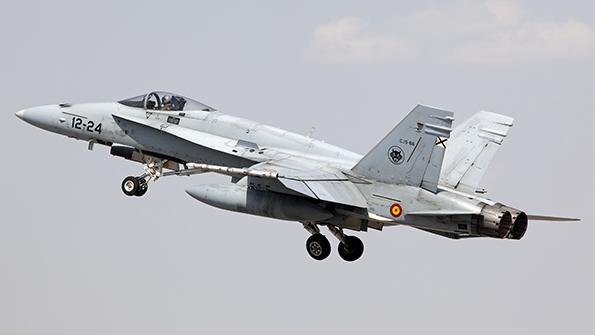
The first phase of Spain’s Halcon 2 program is focused on replacing the EF-18M Hornet fleet with Eurofighters.
A renewed fleet of fighter aircraft—possibly including Lockheed Martin’s F-35 as well as uncrewed aircraft systems and maritime patrol aircraft—is in the cards for Spain as the country begins a long-awaited renewal of its combat capabilities.
Partly driven by the Russian invasion of Ukraine, Spain is planning a steady rise in defense spending to 2% of GDP by the end of the decade, enabling expenditures on a wide range of new equipment.
- Hornet replacement plans could include “fifth-generation” aircraft
- Spain is adding new trainers, UAVs, maritime patrollers and tankers
This coming budget cycle is enabling a “recuperation” of the Spanish Air and Space Force, the service’s chief of staff, Gen. Javier Salto Martinez-Avial, told attendees of the Feindef defense exhibition here on May 17. Salto laid out a long list of priorities, including: “an improvement in the sustainability of the air force . . . improving pilot training with better aircraft and simulators” and regenerating the air force’s infrastructure.
It is all a far cry from the Spanish Air Force of 10 years ago, when the government made deep cuts in public expenditure during the global financial crisis. Spain’s defense spending was at the time barely more than 1% of GDP, just ahead of Luxembourg’s rate, leaving pilots flying fewer hours and with several fleets withdrawn from use to save money (AW&ST Dec. 9, 2013, p. 35).
Among Salto’s priorities this year is to secure parliamentary approvals for an additional top-up order of Eurofighters—about 25—as part of the planned Halcon 2 program. This is on top of Spain’s increased order for Eurofighters signed at last year’s ILA Berlin air show. As part of the Halcon 1 program, 20 Tranche 4 aircraft were ordered to replace early-model McDonnell Douglas F/A-18A/Bs that are being flown from Spain’s Canary Islands.
The Halcon 2 program has two phases. The first would replace the remaining F/A-18 Hornets, designated the EF-18M by the Spanish Air Force, and potentially the Spanish Navy’s AV-8B Harrier fleet. The second phase also could enable the acquisition of a “fifth-generation” platform, Salto said.
No one in Spain is saying “F-35” just yet, however, even though the Joint Strike Fighter is the only Western fifth-generation combat aircraft currently available. It also is the only option Spain has if it wants to retain a fixed-wing combat capability for its aircraft carrier, the Juan Carlos I.
The Spanish Air Force traditionally has had at least two fighter types in its front-line fleet. One is usually U.S.-supplied, the other generally from Europe. A mixed fleet of Eurofighters and F-35s would align with those of other European air forces.
There are sensitivities to consider, however. Spain is a partner on the European Future Combat Air System and is investing in that program as it purchases its renewed combat air fleet.
It is unclear in which configuration or tranche the 25 new Eurofighters are to be delivered, something that is being discussed between the service and industry. Salto said he wants the most advanced configuration available—preferring not to wait for proposed new configurations, such as the Long-Term Evolution initiative for the Eurofighter. The retirement of the Hornet would mean the standoff attack role with Spain’s Taurus KEPD 350 air-launched cruise missile would have to be transferred from the Hornet to the Eurofighter. Integration of the weapons is now envisaged for the Phase 4 enhancements.
Salto’s other priorities include figuring out how to “recuperate the capabilities we have lost,” he told Feindef attendees. Over the past two years, the air force has acquired new strategic aerial refueling aircraft, Airbus A330 Multi-Role Tanker Transports that are planned to replace the KC-707s retired in 2016. Airbus is converting one of the A330s, an ex-Iberia aircraft, to tanker configuration.
Spain’s training fleet of indigenously developed CASA C-101 Aviojets is being replaced with turboprop Pilatus PC-21s. Spain boosted its original order for 24 aircraft by contracting for an additional 16 in March.
A capability gap left open by the retirement of the Lockheed P-3 Orion maritime patrol aircraft in December is set to be closed by the acquisition of anti-submarine-warfare-configured Airbus C295s. The shape of that configuration is being negotiated by the Spanish government and Airbus, with a contract expected this year. Contracts are planned to be signed for the development of Airbus’ Sirtap tactical uncrewed aircraft system as well, which is being developed in Spain to meet the nation’s army and air force requirements.
Less clear is the future of Spain’s Northrop SF-5 Freedom Fighter fleet, used for lead-in fighter training. The proposed development of a new indigenous jet trainer that could have replaced the SF-5s has been dropped, and Salto said Spain is waiting to see what France and Germany choose to prepare their pilots for the Future Combat Air System—both those nations also rely on aging jet trainer fleets. More crucially, perhaps, Salto wants to rebuild air force personnel numbers, noting that 5,000 people have left the service in recent years. “The air force needs these personnel to accomplish its missions,” he said.




